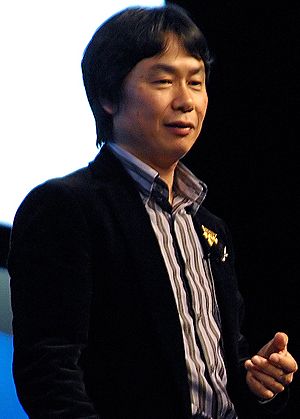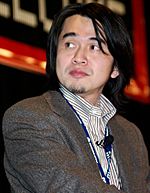- This page was last modified on 17 October 2025, at 11:18. Suggest an edit.
Nintendo Entertainment Analysis & Development facts for kids
|
Native name
|
任天堂情報開発本部
|
|---|---|
|
Romanized name
|
Nintendō Jōhō Kaihatsu Honbu |
|
Formerly
|
Nintendo Research & Development No.4 Department (until early 90s) |
| Division | |
| Industry | Video games |
| Fate | Merged with Nintendo Software Planning & Development |
| Predecessors |
|
| Successor | Nintendo Entertainment Planning & Development |
| Founded | September 30, 1983 in Kyoto, Japan |
| Founder | Hiroshi Yamauchi |
| Defunct | September 16, 2015 |
| Headquarters |
,
Japan
|
|
Number of locations
|
2 (Kyoto and Tokyo) |
|
Key people
|
|
| Products | List of games developed |
| Services | Video game development |
| Parent | Nintendo |
Nintendo Entertainment Analysis & Development Division, often called Nintendo EAD, was the biggest team that made video games for the Japanese company Nintendo. Before this name, it was known as Nintendo Research & Development No.4 Department (or Nintendo R&D4).
This team was famous for creating many popular game series. These include Donkey Kong, Mario, The Legend of Zelda, F-Zero, Star Fox, Animal Crossing, Pikmin, and Wii games.
Two important designers, Shigeru Miyamoto and Takashi Tezuka, were part of an earlier team called the Creative Department. They later became managers at Nintendo EAD and helped make almost every game the division created.
In September 2015, Nintendo EAD joined with another Nintendo team, Nintendo Software Planning & Development. Together, they became a new division called Nintendo Entertainment Planning & Development. This change happened after the company's president, Satoru Iwata, passed away.
Contents
History of Nintendo EAD
How it Started
In the 1970s, Nintendo mostly made toys. But they decided to start making video games too. They hired designers for their "Creative Department," which was their only game-making team back then.
One of these new designers was Shigeru Miyamoto, who would later create many famous Nintendo games. In 1972, the department changed its name to Research & Development Department. It had about 20 employees. Later, this department split into three groups: Nintendo R&D1, R&D2, and R&D3.
Creating Research & Development 4 (R&D4)
Around 1983 or 1984, the game Donkey Kong, designed by Shigeru Miyamoto, became very popular. Because of this success, Nintendo decided to create a new team. This team was called Research & Development No. 4 Department, or Nintendo R&D4.
This new team focused on making games for home consoles. Hiroshi Yamauchi, who was Nintendo's president, approved this new department. Hiroshi Ikeda became the general manager, and Miyamoto became the chief producer. Miyamoto later became one of the most famous video game creators in the world. Other important designers like Takashi Tezuka also joined the team.
At first, Nintendo R&D4 mainly made games for the Family Computer (Famicom), which was known as the Nintendo Entertainment System (NES) in other parts of the world. They also focused on games for handheld consoles like the Game Boy, which was very popular worldwide. This helped R&D4 become Nintendo's main team for making games for home consoles.
The R&D4 team, led by Miyamoto, made many creative game ideas. But they needed help with programming. A small company called Systems Research & Development (SRD) was good at computer design and knew a lot about the Famicom. SRD helped Miyamoto's team create their first game, Excitebike.
So, the first R&D4 team included Miyamoto, Takashi Tezuka, and Kenji Miki for design. Koji Kondo and others worked on sound. Toshihiko Nakago and SRD handled the technology and programming.
This team also developed Super Mario Bros. in 1985. This game set new standards for platform games and was a huge success. In 1986, R&D4 created The Legend of Zelda, with Miyamoto as director again. The success of these games helped the department grow, bringing in new game designers like Hideki Konno and Katsuya Eguchi.
Becoming Entertainment Analysis & Development (EAD)
In 1989, Nintendo R&D4 changed its name to Nintendo Entertainment Analysis & Development, or Nintendo EAD. This happened before the Super Famicom console was released.
The new division had two main parts:
- The Software Development Department, led by Miyamoto, focused on making games.
- The Technology Development Department focused on programming and creating tools for game development.
F-Zero, released in 1990, was the first game fully programmed by this division. Before that, much of the programming was done by SRD.
In 1997, Miyamoto shared that about 20 to 30 people worked on each Nintendo EAD game. He also mentioned that SRD, a programming company, had about 200 skilled programmers working with the division.
In 2000, Nintendo changed how its top management worked. Shigeru Miyamoto and Genyo Takeda joined the board of directors. This meant Miyamoto was now in charge of all of Nintendo's software development. To fill his old role, Takashi Tezuka became a deputy general manager. Other senior directors like Eiji Aonuma, Hideki Konno, and Katsuya Eguchi became producers, leading their own game development teams.
In 2002, Nintendo opened a new Nintendo EAD studio in Tokyo. Takao Shimizu became its manager. The goal was to find new talented people in Tokyo who might not want to move to Kyoto. Their first game was Donkey Kong Jungle Beat for the GameCube.
Changes and Mergers (2003–2015)
On September 30, 2003, Nintendo made more changes to its company structure. Some members from Nintendo R&D1 and R&D2 joined Nintendo EAD. This brought in new managers and producers.
In 2013, Katsuya Eguchi became the manager for both the Kyoto and Tokyo Software Development Departments. Hisashi Nogami took over Eguchi's previous role and later helped create the Splatoon series.
On June 18, 2014, the Nintendo EAD Kyoto team moved to the new Nintendo Development Center in Kyoto. This building brought together over 1100 developers from different Nintendo teams.
Finally, on September 16, 2015, Nintendo EAD merged with Nintendo Software Planning & Development. They formed a new, bigger game development division called Entertainment Planning & Development (EPD). This was part of a big change at Nintendo after the death of former president Satoru Iwata in July 2015.
How Nintendo EAD Was Organized
The Nintendo Entertainment Analysis & Development division was led by Takashi Tezuka. It had two main game development departments: one in Kyoto and one in Tokyo. Katsuya Eguchi was a key leader in Kyoto, and Yoshiaki Koizumi was a key leader in Tokyo.
Kyoto Software Development Department
This was the largest and oldest game development team at Nintendo, with over 700 game creators. It was located in Kyoto, Japan. In 2014, it moved to the new Nintendo Development Center.
This department included many famous Nintendo producers:
- Hideki Konno, who produced the Nintendogs and Mario Kart games.
- Katsuya Eguchi, who produced the Wii and Animal Crossing games.
- Eiji Aonuma, who produced The Legend of Zelda games.
- Hiroyuki Kimura, who produced Big Brain Academy, Super Mario Bros., and Pikmin games.
- Tadashi Sugiyama, who produced Wii Fit, Steel Diver, and Star Fox games.
Tokyo Software Development Department
The Nintendo EAD Tokyo Software Development Department was started in 2002. Its goal was to find new talented people in Tokyo who might not want to move to Kyoto. It was located in the Nintendo Tokyo Office.
In 2003, twenty people from the Kyoto team moved to Tokyo to help start this new office. These people were mostly from the team that made Super Mario Sunshine. This move helped Nintendo hire more developers who preferred living in Tokyo.
Takao Shimizu and Yoshiaki Koizumi led this new team. They hired people from other game companies like SEGA and Square-Enix. Their first project was Donkey Kong Jungle Beat. Later, they released the very popular Super Mario Galaxy in 2007. After Super Mario Galaxy, Koizumi became a manager and producer, and they opened a second Tokyo team.
Games Developed by Nintendo EAD
Nintendo EAD made many well-known games for various Nintendo consoles. Here are some of the most famous ones:
- Super Mario Bros. (1985) - NES
- The Legend of Zelda (1986) - NES
- Super Mario Bros. 3 (1988) - NES
- Super Mario World (1990) - SNES
- F-Zero (1990) - SNES
- The Legend of Zelda: A Link to the Past (1991) - SNES
- Super Mario Kart (1992) - SNES
- Star Fox (1993) - SNES
- Super Mario 64 (1996) - Nintendo 64
- Mario Kart 64 (1996) - Nintendo 64
- The Legend of Zelda: Ocarina of Time (1998) - Nintendo 64
- The Legend of Zelda: Majora's Mask (2000) - Nintendo 64
- Luigi's Mansion (2001) - GameCube
- Pikmin (2001) - GameCube
- Animal Crossing (2001) - GameCube
- Super Mario Sunshine (2002) - GameCube
- The Legend of Zelda: The Wind Waker (2002) - GameCube
- Mario Kart: Double Dash (2003) - GameCube
- Donkey Kong Jungle Beat (2004) - GameCube
- Super Mario 64 DS (2004) - Nintendo DS
- Nintendogs (2005) - Nintendo DS
- Mario Kart DS (2005) - Nintendo DS
- Animal Crossing: Wild World (2005) - Nintendo DS
- New Super Mario Bros. (2006) - Nintendo DS
- The Legend of Zelda: Twilight Princess (2006) - GameCube, Wii
- Wii Sports (2006) - Wii
- Super Mario Galaxy (2007) - Wii
- Mario Kart Wii (2008) - Wii
- Wii Fit (2008) - Wii
- New Super Mario Bros. Wii (2009) - Wii
- Super Mario Galaxy 2 (2010) - Wii
- Super Mario 3D Land (2011) - Nintendo 3DS
- Mario Kart 7 (2011) - Nintendo 3DS
- The Legend of Zelda: Skyward Sword (2011) - Wii
- Animal Crossing: New Leaf (2012) - Nintendo 3DS
- New Super Mario Bros. U (2012) - Wii U
- Pikmin 3 (2013) - Wii U
- Super Mario 3D World (2013) - Wii U
- Mario Kart 8 (2014) - Wii U
- Captain Toad: Treasure Tracker (2014) - Wii U
- Splatoon (2015) - Wii U
- Super Mario Maker (2015) - Wii U
Images for kids
See also
 In Spanish: Nintendo Entertainment Analysis and Development para niños
In Spanish: Nintendo Entertainment Analysis and Development para niños






